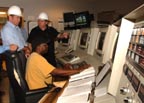March 01, 2006
Anheuser-Busch chief tours SIUC's steam plant
CARBONDALE, Ill. -- Heat and grain are two key ingredients in making beer. One of the country's leading beer-makers swooped into Southern Illinois University Carbondale today (March 1) to examine a process that deals with both.
August A. Busch III, chairman of the board of Anheuser-Busch Cos., piloted his own helicopter to a pinpoint landing in the parking lot of the SIU Arena at about 10:40 a.m. Busch, accompanied by several executives, visited SIUC to learn more about the University's main source of heating and cooling energy, the "circulating fluidized bed boiler," located at the University's Physical Plant along U.S. Highway 51.
The 10-year-old plant uses what was once experimental technology – now proven – to burn high-sulfur Illinois coal cleanly and efficiently. The plant also can burn different substances, such as wood or rubber tires, along with the coal to make the steam that runs the University's heating and air conditioning units.
Anheuser-Busch is considering constructing similar plants at several breweries, and is investigating the efficiency, environmental impact and reliability of such equipment. The team was the latest in a series of groups to visit SIUC for the purpose of learning more about its boiler unit, which has acquired a national reputation as a leading example of clean coal technology.
"We appreciate very much the opportunity to look at the University's boiler because we want to put one of these in," said Busch, as he finished a whirlwind overview and plant tour given by
SIUC officials. "We use Illinois coal, and if we can use a unit like this to burn high-sulfur coal in an environmentally friendly way, we're interested in doing that."
Philip S. Gatton, director of plant and service operations for SIUC, said the campus boiler operation is extremely reliable and highly automated.
"The system is always monitoring itself, controlling its feed rates and other factors," Gatton said. "It puts all the information into equations and readjusts."
The combustion process involves mixing small pieces of coal with limestone and using a powerful air stream to suspend that burning mixture along with other combustible materials inside a burn chamber. As the small pieces rise to the top of the chamber they collide with "U beams," arched pieces of metal that direct the burning material back down into the heat for further combustion.
The process allows the material to burn more completely at a lower temperature, increasing efficiency and reducing the amount of sulfur and other gases created in the process. Combining the coal with limestone further decreases emissions by making the byproducts a solid ash, which can be easily captured by filters. The limestone ash byproduct can be disposed of in many ways, including burial in closed coal mines, as a soil additive or in concrete.
Steam created by the process heats and cools campus buildings and also drives a small electric turbine. Gatton said the plant, which was online about 99 percent of the time in 2005, supplies 70 percent of the annual energy needed on campus.
Built at a cost of about $35 million from 1993 through 1996, Gatton said the plant makes Illinois' high-sulfur coal more attractive.
"We try to promote Illinois products and we want to burn Illinois coal," he said. "We had one opportunity to build something that would do that. This unit basically can burn about anything,"
Anheuser-Busch is looking at two issues: generating steam for energy and disposing of the tons of grain waste inherent in its brewing operations. Burning that waste with coal might solve both issues and Busch said he hopes SIUC might also play a role in the company's decision by agreeing to test-burn some such waste grains on site.
SIUC gets its coal from a mine in nearby Pinckneyville. Busch said the company wants the technology to burn the most affordable coal, which tends to come from Illinois. The company is considering building plants that are about the same size as SIUC's, which can generate up to 120,000 pounds of steam per hour.
Richard Guye, plant manager, said several other groups, including the University of Iowa and Purdue University, also recently visited the SIUC operation as they consider building similar plants.
"It's not new technology, but it works," said Guye, who led Busch and other executives on a 20-minute tour of the facility. "You can drive by the plant on any given day and you can't tell if we're operating or not by looking at the smoke stack. It works very well."
Utilizing key University programs and resources to assist in the development of the coal, energy and manufacturing sectors in the region is among the goals of Southern at 150: Building Excellence Through Commitment, the blueprint the University is following as it approaches its 150th anniversary in 2019.
(Caption: Taking a look – August A. Busch III, left, chairman of the board of Anheuser-Busch Cos., examines the control center for the circulating fluidized bed boiler at Southern Illinois University Carbondale Wednesday morning. Richard Guye, top center, plant manager, explains the plant’s operations as Michael Lacey, operating engineer, sits at the controls. Busch and several company executives visited SIUC’s boiler operation as the company considers building similar clean coal boilers for some of its operations.)

